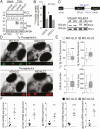A Novel SLC5A5 Variant Reveals the Crucial Role of Kinesin Light Chain 2 in Thyroid Hormonogenesis
- PMID: 33912899
- PMCID: PMC8208674
- DOI: 10.1210/clinem/dgab283
A Novel SLC5A5 Variant Reveals the Crucial Role of Kinesin Light Chain 2 in Thyroid Hormonogenesis
Abstract
Context: Iodide transport defect (ITD) (Online Mendelian Inheritance in Man No. 274400) is an uncommon cause of dyshormonogenic congenital hypothyroidism due to loss-of-function variants in the SLC5A5 gene, which encodes the sodium/iodide symporter (NIS), causing deficient iodide accumulation in thyroid follicular cells.
Objective: This work aims to determine the molecular basis of a patient's ITD clinical phenotype.
Methods: The propositus was diagnosed with dyshormonogenic congenital hypothyroidism with minimal 99mTc-pertechnetate accumulation in a eutopic thyroid gland. The propositus SLC5A5 gene was sequenced. Functional in vitro characterization of the novel NIS variant was performed.
Results: Sanger sequencing revealed a novel homozygous missense p.G561E NIS variant. Mechanistically, the G561E substitution reduces iodide uptake, because targeting of G561E NIS to the plasma membrane is reduced. Biochemical analyses revealed that G561E impairs the recognition of an adjacent tryptophan-acidic motif by the kinesin-1 subunit kinesin light chain 2 (KLC2), interfering with NIS maturation beyond the endoplasmic reticulum, and reducing iodide accumulation. Structural bioinformatic analysis suggests that G561E shifts the equilibrium of the unstructured tryptophan-acidic motif toward a more structured conformation unrecognizable to KLC2. Consistently, knockdown of Klc2 causes defective NIS maturation and consequently decreases iodide accumulation in rat thyroid cells. Morpholino knockdown of klc2 reduces thyroid hormone synthesis in zebrafish larvae leading to a hypothyroid state as revealed by expression profiling of key genes related to the hypothalamic-pituitary-thyroid axis.
Conclusion: We report a novel NIS pathogenic variant associated with dyshormonogenic congenital hypothyroidism. Detailed molecular characterization of G561E NIS uncovered the significance of KLC2 in thyroid physiology.
Keywords: dyshormonogenic congenital hypothyroidism; impaired transport to the plasma membrane; iodide transport defect; kinesin light chain 2; sodium/iodide symporter; tryptophan-acidic motif.
© The Author(s) 2021. Published by Oxford University Press on behalf of the Endocrine Society. All rights reserved. For permissions, please e-mail: journals.permissions@oup.com.
Figures




References
-
- Szinnai G. Genetics of normal and abnormal thyroid development in humans. Best Pract Res Clin Endocrinol Metab. 2014;28(2):133-150. - PubMed
-
- Fujiwara H, Tatsumi K, Miki K, et al. . Congenital hypothyroidism caused by a mutation in the Na+/I– symporter. Nat Genet. 1997;16(2):124-125. - PubMed
-
- Matsuda A, Kosugi S. A homozygous missense mutation of the sodium/iodide symporter gene causing iodide transport defect. J Clin Endocrinol Metab. 1997;82(12):3966-3971. - PubMed
-
- Nicola JP, Carrasco N, Masini-Repiso AM. Chapter one—Dietary I– absorption: expression and regulation of the Na+/I– symporter in the intestine. Vitam Horm. 2015;98:1-31. - PubMed
Publication types
MeSH terms
Substances
Grants and funding
LinkOut - more resources
Full Text Sources
Other Literature Sources
Molecular Biology Databases

